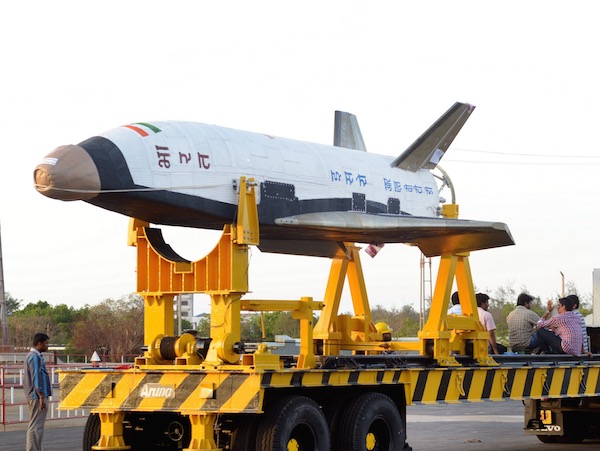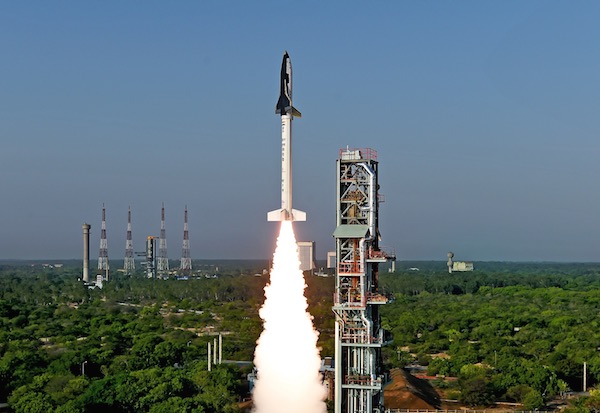Apples and oranges: Why comparing India’s reusable launch vehicle with the space shuttle is totally out of placeby Kiran Krishnan Nair
|
| Simply put, the test does not herald the addition of an Indian Space Shuttle to ISRO’s inventory straightaway; it only marks the beginning of a technically challenging endeavor. |
Lost amidst the din and noise of jubilation is the cautious optimism of ISRO that stays clear of adjectives and self-adulation, simply stating that the test is but a technology demonstration and nothing more than an initial test. For instance, Dr. K Sivan, director of ISRO’s Vikram Sarabhai Space Centre (VSSC), states, “What we do now is only a demonstration. It is no way near to the real RLV. It is like a drop test to bring back a launched vehicle to some point. It is just a baby step towards the giant leap.” On the other hand, Jitendra Singh, India’s Minister of State in the Prime Minister’s Office said in March 2015, “Development of RLV is a technical challenge and it involves development of cutting edge technologies. The magnitude of cost reduction depends on development and realization of fully reusable launch vehicle and its degree of reusability.”
Tempering hype with reality
India is inherently multi-cultural and, unlike any other nation, every month, if not week, is witness to some kind of festival. While the cultural proclivity to celebrate has its uses, premature jubilation and hype also carries the hazard of raising expectations unreasonably. Hence, it augurs well for India to temper hype with reality.
Simply put, the test does not herald the addition of an Indian Space Shuttle to ISRO’s inventory straightaway; it only marks the beginning of a technically challenging endeavor. Actual operations of such a vehicle is at least a decade away and that is the stark reality. Contrary to popular belief, the commercial meter does not start clicking straightaway, and no RLVs will be launching and gliding back ever so frequently come June 2016.
In order to be more reasonable in our expectations of the Indian RLV, it is essential to briefly examine the program. The May 2016 test of the RLV-TD is part of a series of technology demonstration missions that are the initial steps to developing a two-stage-to-orbit (TSTO) fully reusable vehicle. In this preliminary suborbital mission, a double-delta winged vehicle that more or less resembles an aircraft launched from the Sriharikota High Altitude Range (SHAR) atop a two-stage Rohini sounding rocket. The 6.5 meter-long vehicle, weighing 1.75 tonnes, flew to an altitude of about 65 kilometers before descending to land at a particular point on the sea.
The winged RLV-TD has been configured to act as a flying testbed to evaluate various technologies using air-breathing propulsion. These technologies will be developed in phases through a series of experimental flights. The first is a Hypersonic Experiment (HEX) flight, followed by the Landing Experiment (LEX), Return Flight Experiment (REX), and Scramjet Propulsion Experiment (SPEX). It is here that ISRO’s assertion needs attention: as per ISRO, the May test is but a baby step and not a giant leap or a Hanuman leap. The HEX flight was intended to serve to:
- Demonstrate capability of HEX vehicle to survive atmospheric re-entry.
- Qualify and validate the aerodynamic design characteristics during hypersonic flight.
- Qualify and validate the avionics, aerodynamic control, and guidance systems.
- Characterize induced loads during hypersonic re-entry into the atmosphere.
- Assess thermal protection systems like performance of materials like the carbon fiber used in construction of the nose of the vehicle.
- Demonstrate mission management competencies like first stage separation sequencing.
- Demonstrate competency of recovery of the HEX vehicle from sea.
Thus, the primary emphasis in the May 2016 HEX flight is on assessment of the hypersonic aerodynamic characteristics, thermal management, autonomous mission management and ability to land at a specific location.
Landing and recovery though part of the test are not the prime elements. With regards to recovery experiments, ISRO already has demonstrated capabilities. This will be ISRO’s third effort to recover a spacecraft after launch and evaluate the re-entry characteristics. The first was the unmanned 555-kilogram Space Capsule Recovery Experiment (SRE-1), which was launched on January 10, 2007 by a PSLV and recovered on January 22. The second was the Crew Module Atmospheric Re-entry Experiment (CARE), launched on board the maiden flight of the GSLV Mark 3 on December 18, 2014. After a 19-minute flight, the uncrewed module splashed down in the Bay of Bengal and was recovered by the coast guard and handed over to ISRO.
| Elevating India’s May 2016 RLV-TD test to the same level as the shuttle prior to the launch is premature and inappropriate. |
The experience and knowledge gained by the SRE-1 and CARE missions will be used for the human spaceflight program. While the RLV-TD flight has nothing to do with human missions, the experiment has great utility and hence the landing tests would add to competencies of ISRO. Nonetheless, the landing experiments (LEX) phase is yet to follow. Quite clearly, what is planned for May is but the first small step in a series of tests. One needs to be cognizant of the challenges inherent in the endeavor before prematurely raising expectations to the same levels as the American Space Shuttle.
 The RLV-TD being prepared for launch. (credit: ISRO) |
Comparisons with the US Space Shuttle
In retrospect, the US Space Shuttle is also far from a grand success. Both its performance and cost have been subject to intense criticism. The US, for instance, spent an estimated $192 billion on the shuttle program from 1971 to 2010. The average cost per launch works out to $1.2 billion, which is as much as the total annual Indian space budget. It is a costly experiment that India can ill-afford.
On the other hand, India’s endeavor is challenging in that spaceplanes have not met with much success elsewhere. For example, the Hermes spaceplane, a collaborative effort of the French space agency CNES and the European Space Agency, was approved in November 1987 but cancelled in 1992 as it suffered numerous delays and funding problems. The HOPE-X of the Japanese Space Agency was started in the 1980s, but was scrapped in 2003 for a variety of reasons, mainly financial. The Soviet Union started Buran in 1974 in response to the Space Shuttle program. It completed one unmanned orbital spaceflight in 1988 before it was cancelled in 1993.
The Space Shuttle flew from 1981 to 2011 covering a total of 135 missions. Despite its numerous achievements, like launching satellites and repairing the Hubble Space Telescope, the feeling among NASA officials and space experts was that the shuttle failed to achieve its promised cost and utility goals. Another major criticism was that it failed to lower the cost of access to space. An analysis showed that the incremental per-pound launch costs turned to be higher than those of regular expendable rockets.
Thus, elevating India’s May 2016 RLV-TD test to the same level as the shuttle prior to the launch is premature and inappropriate. Equally so is the comparison considering that:
- The RLV-TD is but a test and the Space Shuttle was a fully operational vehicle.
- The RLV is yet to demonstrate landing and reuse capability akin to the Space Shuttle.
- The Indian RLV is being designed to launch payloads/satellites into space and not for carrying humans into space like the Space Shuttle. India has no space station and hence the requirement of a human-certified serospace plane is some time away.
- The cost differences in the projects are phenomenal: the RLV test costs 950 million rupees (US$14 million), while the overall shuttle program cost the US $192 billion.
Many other huge differences exist between the two, and thus it’s essential to perceive the RLV in light of its own competencies and unique Indian purpose, rather than draw unfair comparisons with the Space Shuttle.
The distinct gains of the Indian RLV
| Overall, disassociating expectations from the Space Shuttle and viewing the RLV in a uniquely Indian context makes more sense. |
Development and operations of an Indian RLV makes more sense when viewed in light of India’s quest of using space for national growth and civil development. A human rating for the RLV, or using it for crewed missions, would be quite some time away, but the RLV certainly has enormous uses to plug gaps in Earth observation and communications. It also has enormous dividends when viewed in light of India’s growing competencies in miniaturization, nanotechnologies, and microsatellites. India has already demonstrated the ability for microsatellite launches in multiple orbits and, coupled with RLV capabilities, the gains for the country are enormous. The commercial gains are also extremely significant. India already boasts of highly affordable and reliable launch capabilities in the international market. An RLV should take India’s capabilities and competencies much higher.
Overall, disassociating expectations from the Space Shuttle and viewing the RLV in a uniquely Indian context makes more sense. While celebrating success, it augurs well for the country to not lose sight of the original developmental vision of the doyen of the Indian space program, Shri Vikram Sarabhai: “Our vision is to harness space technology for national development, while pursuing space science research and planetary exploration.” With development, pride automatically accrues and hence we need to perceive the RLV as symbolic of national development.
